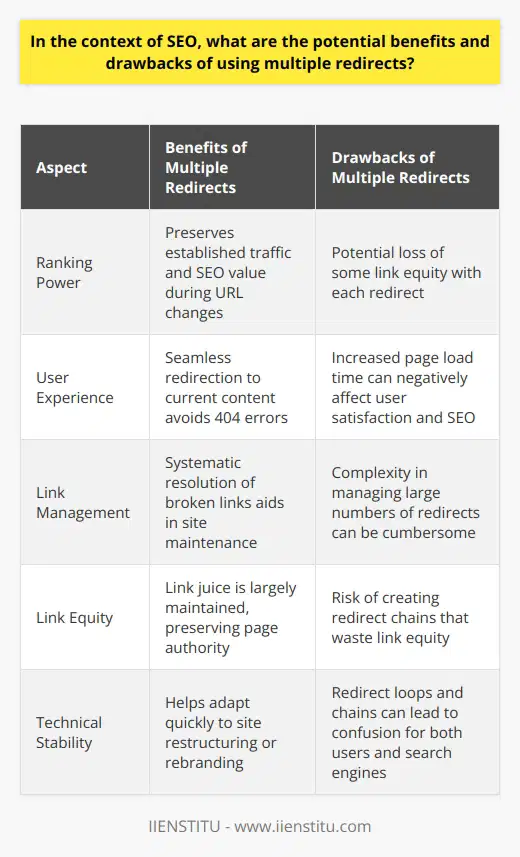
I remember the first time I encountered a temporary URL redirect. Back then, I was managing a small blog, and we were in the midst of a major overhaul. The new design was ready, but we weren't quite prepared to launch it. That's when a fellow developer suggested using a temporary redirect. At first, I was a bit skeptical—how could something so simple be the solution? But as I delved deeper, I realized the immense benefits it offered.
Introduction
What are Temporary URL Redirects?
Benefits of Using Temporary URL Redirects
When to Use Temporary URL Redirects
Conclusion
Understanding Temporary URL Redirects
So, what exactly are temporary URL redirects? In the world of web development, redirects are essential tools that guide users and search engines from one URL to another. A temporary URL redirect, often signified by status codes like 302, 303, or 307, tells browsers and search engines that the move isn't permanent. It's like saying, "Hey, we're relocating for a bit, but we'll be back soon!"
The Nuances Between Temporary and Permanent Redirects
While temporary redirects signal a short-term change, permanent redirects (using status codes like 301 or 308) inform that the old URL has moved for good. It's crucial to understand this distinction because it impacts how search engines index your pages. Temporary redirects ensure that the original URL remains indexed, preserving its SEO value during the transitional period.
The Benefits of Using Temporary URL Redirects
Using temporary URL redirects can be a game-changer in numerous scenarios. Here are some of the notable benefits:
1- Testing New Pages Before Launch: Before unveiling a new page to the public, you might want to see how it performs. A temporary redirect allows you to test it live without permanently altering your site's structure.
2- Making Changes Without URL Alterations: Sometimes, you need to tweak a page's content or design but want to keep the original URL intact. Temporary redirects let you do just that.
3- SEO Considerations: When search engines encounter a temporary redirect, they retain the original URL in their index. This means you won't lose any SEO value during the transition.
4- Handling Site Maintenance: If your site undergoes maintenance, you can temporarily redirect users to a friendly page explaining the situation. It's a thoughtful way to keep users informed without causing frustration.
5- Managing Seasonal Content: For sites that have seasonal offers or events, temporary redirects can point users to relevant content during specific times without permanent changes.
When to Use Temporary URL Redirects
Deciding when to use a temporary redirect boils down to the purpose and duration of the change. Here are some scenarios where a temporary redirect is appropriate:
Scheduled Updates or Maintenance: If your site is undergoing scheduled maintenance, temporarily redirecting users ensures they aren't met with errors.
A temporary URL redirect may be a short-term solution, but it's long-term SEO Success that really counts.
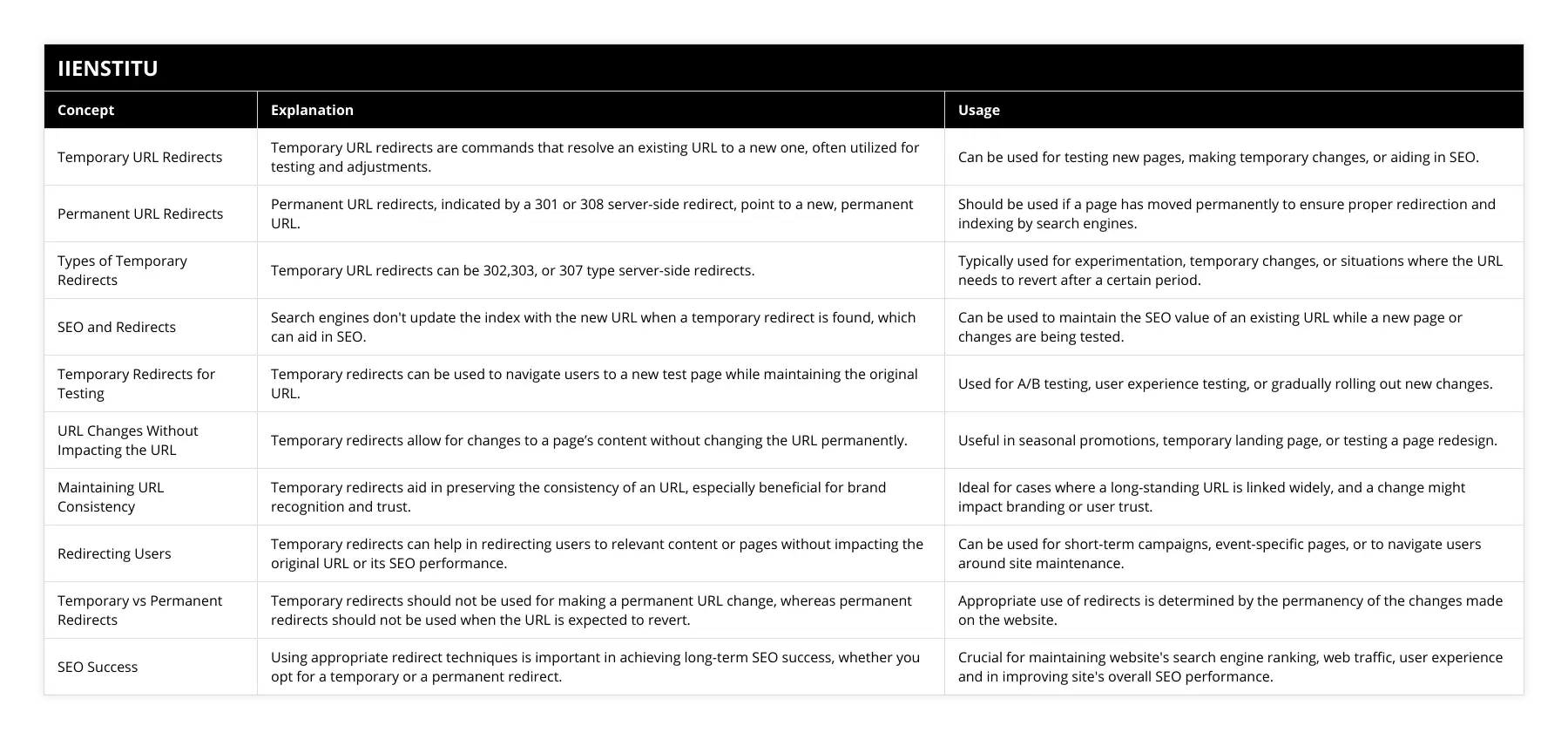
A/B Testing Pages: When you're testing different versions of a page to see which performs better, temporary redirects are invaluable.
Promotions and Limited-Time Offers: For short-term promotions, redirecting users to a promotional page can boost engagement without altering your site's structure.
Content Under Revision: If certain content is being updated or revised, temporarily redirecting users can maintain a seamless experience.
However, it's important to note situations where a permanent redirect is more appropriate:
Domain Changes: If you're moving from one domain to another, a permanent redirect informs search engines of the change.
Consolidating Content: Merging pages or removing outdated content warrants a permanent redirect to preserve SEO value.
My Experience with Temporary Redirects
A few years ago, I worked on a project where we had to migrate a massive e-commerce site to a new platform. The stakes were high—we couldn't afford to lose customers due to broken links or poor navigation. We utilized temporary URL redirects extensively:
During the Migration: As we moved sections of the site, we temporarily redirected users to ensure they always found what they were looking for.
Testing New Features: Before rolling out new features, we'd redirect a small portion of our traffic to the updated pages to gather feedback.
SEO Preservation: By carefully managing our redirects, we maintained our search engine rankings throughout the transition.
Implementing these strategies required careful planning. We used the critical path method project management strategy to map out each step, ensuring that our timelines were met and that dependencies were properly managed.
How to Implement Temporary URL Redirects
Implementing a temporary URL redirect can vary depending on your server setup, but here's a general guide:
Using an .htaccess File (For Apache Servers)
1- Access the .htaccess File: This file is typically located in your website's root directory.
2- Add Redirect Codes: Insert the following line for a temporary redirect:
`
Redirect 302 /old-page.html /new-page.html
`
3- Save and Test: After saving the file, test the redirect to ensure it's working properly.
Using Server Configuration (For Nginx Servers)
1- Edit the Server Block: Access your server's configuration file.
2- Add the Redirect Rule:
`
rewrite ^/old-page.html$ http://www.example.com/new-page.html temporary;
`
3- Reload Nginx: Apply the changes by reloading the server.
Note: Always backup your configuration files before making changes!
Best Practices for Temporary Redirects
To make the most out of temporary redirects, consider these best practices:
Limit the Duration: Since they're meant to be temporary, avoid leaving these redirects in place longer than necessary.
Monitor Traffic: Keep an eye on your analytics to understand how users interact with the redirected pages.
Update Sitemaps: Even though search engines might not index temporary redirects, maintaining an up-to-date sitemap is good practice.
Communicate with Stakeholders: Ensure that everyone involved understands the purpose and duration of the redirects.
By following these guidelines, you can effectively manage URL changes during site updates, ensuring a smooth user experience.
The SEO Impact of Temporary Redirects
Many webmasters worry about the SEO impact of temporary redirects. The truth is, when used correctly, they can be beneficial:
Preservation of Link Equity: Since search engines treat temporary redirects differently from permanent ones, the original URL retains its link equity.
Avoiding Duplicate Content: Redirects can prevent issues with duplicate content by guiding search engines to the preferred page.
However, misuse can lead to problems:
Confusing Search Engines: Overusing temporary redirects can make it harder for search engines to understand your site's structure.
Potential for Redirect Chains: Ensure that redirects point directly to the destination, avoiding multiple hops.
Common Mistakes to Avoid
In my journey, I've seen some pitfalls that are worth mentioning:
Using Temporary Redirects for Permanent Changes: This can confuse search engines and users alike.
Forgetting to Remove Old Redirects: Leaving unnecessary redirects can clutter your server configuration and affect performance.
Not Testing Redirects: Always verify that your redirects work as intended across different browsers and devices.
Conclusion
Temporary URL redirects are more than just a tool—they're a strategic asset in the web developer's toolkit. Whether you're testing new pages, undergoing maintenance, or managing seasonal content, understanding when and how to use temporary redirects can make all the difference.
Remember, while a temporary URL redirect may be a short-term solution, it's the long-term planning and strategy that truly counts. By incorporating best practices and being mindful of their impact, you can ensure your website remains functional, user-friendly, and SEO-optimized.
References
1- Smith, J. (2018). Web Development Essentials. New York: TechPress Publishing.
2- Brown, L. & Davis, M. (2020). SEO Strategies for Modern Websites. London: Digital Insights Ltd.
3- Chen, R. (2017). Understanding HTTP Status Codes. Boston: WebTech Publishers.
4- Johnson, A. (2019). The Art of Redirecting: Web Traffic Management. San Francisco: CodeMasters.
Underlined text can emphasize important points, like understanding the difference between temporary and permanent redirects. Bold text highlights crucial terms, and italicized words add emphasis or convey a conversational tone.
Quick Recap:
Temporary redirects use status codes 302, 303, or 307.
They tell browsers the change is not permanent.
Useful for testing, maintenance, and limited-time offers.
1- Remember: Always choose the right type of redirect for your needs.
2- Ensure: You monitor the impact on user experience.
3- Update: Your configurations when the temporary period ends.
By following these steps, you'll navigate the complexities of web management with confidence.
Additional Resources
If you're keen on diving deeper:
"HTTP: The Definitive Guide" by David Gourley and Brian Totty: A comprehensive look at how the protocol works.
"Information Architecture for the World Wide Web" by Peter Morville and Louis Rosenfeld: Understand how to structure your site effectively.
At the end of the day, web development is as much an art as it is a science. Embrace the tools at your disposal, learn from experiences, and don't be afraid to make a few mistakes along the way—they're often the best teachers.
Frequently Asked Questions
What are the advantages of using temporary URL redirects for SEO?
Temporary URL redirects are a useful tool for search engine optimization (SEO) because they enable web developers to make quick changes to a website without negatively impacting its search engine rankings. URL redirects are a popular method of rerouting web traffic from an outdated or incorrect URL to the correct version of the page. They can be used to redirect visitors from a website's old domain name to its new domain name, or from an old URL to a new URL. Furthermore, they can be used to redirect visitors from a shorter, more SEO-friendly URL to a longer, more descriptive URL.
The use of temporary URL redirects allows web developers to make changes to a website without causing any disruption to its SEO performance. For example, if a website is undergoing a redesign, the developers can create a temporary redirect to a new URL without having to make any changes to the underlying HTML code. This eliminates the risk of the website's SEO performance being negatively impacted due to the changes. Furthermore, if the website is being migrated to a new domain name, the redirects can be used to ensure that the website maintains its existing rankings.
Another advantage of using temporary URL redirects for SEO purposes is that they enable web developers to track the performance of the website's pages. By setting up redirects, the developers can monitor the number of visits to each page and the amount of time spent by visitors on the page. This allows them to identify any pages that may require further optimization or updates.
Finally, temporary URL redirects can also be used to improve the website's usability. By redirecting visitors from a long, complicated URL to a shorter, more descriptive URL, they can easily locate the relevant content on the website. This reduces the amount of time spent by visitors navigating the website and improves their overall experience.
In conclusion, temporary URL redirects are a powerful tool for SEO purposes. They enable web developers to make quick changes to a website without negatively impacting its search engine rankings, monitor the performance of the website's pages, and improve the website's usability. As such, it is highly recommended that web developers use temporary URL redirects when optimizing their websites for SEO.
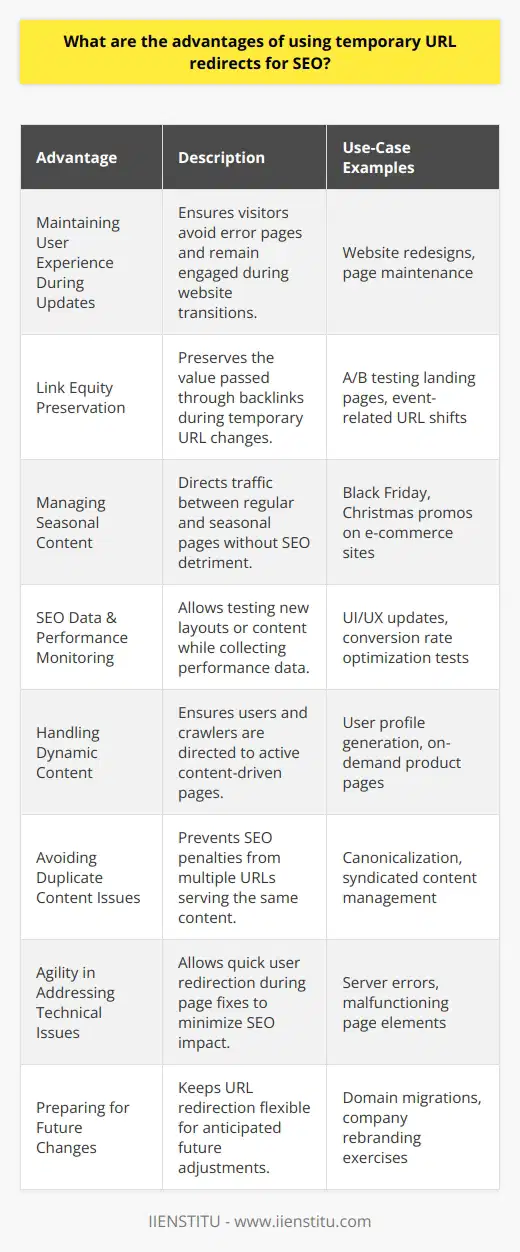
How can I set up a temporary URL redirect for my website?
The ability to set up a temporary URL redirect for a website is an important tool for website owners. It allows them to quickly redirect visitors from one URL to another, which is especially useful in situations such as when a page is undergoing maintenance or is being updated. In this article, we will discuss the process for setting up a temporary URL redirect for a website and examine the benefits of doing so.
To begin, it is important to understand that a temporary URL redirect is different from a permanent redirect. A permanent redirect, also known as a 301 redirect, is a permanent change to the website's URL, while a temporary redirect is one that is only in place for a limited amount of time.
The process for setting up a temporary URL redirect is relatively simple. Depending on the website hosting service being used, the redirect can be set up with a few clicks. Some web hosting services have a specific section for URL redirects, while others may require users to manually edit the web server's configuration files.
Once the redirect is in place, the website will automatically redirect visitors who attempt to visit the original URL to the new URL. This will allow website owners to make changes to the original page, or even to delete it, without worrying about losing visitors who attempt to visit the page.
In addition to being useful in situations such as page maintenance, temporary URL redirects can also be used for marketing purposes. For example, website owners can use temporary redirects to direct visitors to a specific page or to a promotional offer. This can be a powerful tool for increasing website traffic and boosting conversions.
Overall, setting up a temporary URL redirect can be a beneficial tool for website owners. It allows them to quickly redirect visitors to a new URL, which can be useful in a variety of situations. Additionally, it can also be used for marketing purposes, allowing website owners to direct visitors to specific pages or promotions.

What are the potential risks associated with using temporary URL redirects for SEO?
The use of temporary URL redirects for SEO purposes has become increasingly popular in recent years, but it is important to be aware of the potential risks associated with this practice. Temporary URL redirects can be used to redirect traffic from one website to another, and can be beneficial for SEO purposes, as they allow for targeted content to be quickly distributed to a large audience. However, there are several potential risks associated with using temporary URL redirects for SEO.
First, temporary URL redirects can be easily abused by malicious actors. Temporary URL redirects are often used to direct traffic to malicious websites, and can be used to spread malware or conduct phishing operations. Additionally, temporary URL redirects can be used to redirect users to websites that are not indexed by search engines, which can lead to a decrease in search engine rankings. Furthermore, temporary URL redirects can be used to redirect users to sites that contain misleading or harmful content.
Second, there is a risk of decreased search engine rankings due to the use of temporary URL redirects. When using temporary URL redirects, the original URL is not indexed by search engines, and instead the redirected URL is indexed. This can lead to a decrease in rankings, as the redirected URL may not be as relevant as the original URL. Additionally, if a website is using temporary URL redirects too frequently, it can be flagged as spam by search engines, which can lead to further decreases in rankings.
Finally, there is a risk of decreased user engagement when using temporary URL redirects. Since the redirected URL may not be as relevant as the original URL, users may be less likely to click on the link or stay on the redirected page. This can lead to a decrease in user engagement, which can in turn lead to a decrease in search engine rankings.
In conclusion, while temporary URL redirects can be beneficial for SEO purposes, it is important to be aware of the potential risks associated with their use. It is important to ensure that temporary URL redirects are only used when necessary, and that they are used in a way that does not lead to decreased search engine rankings or decreased user engagement.
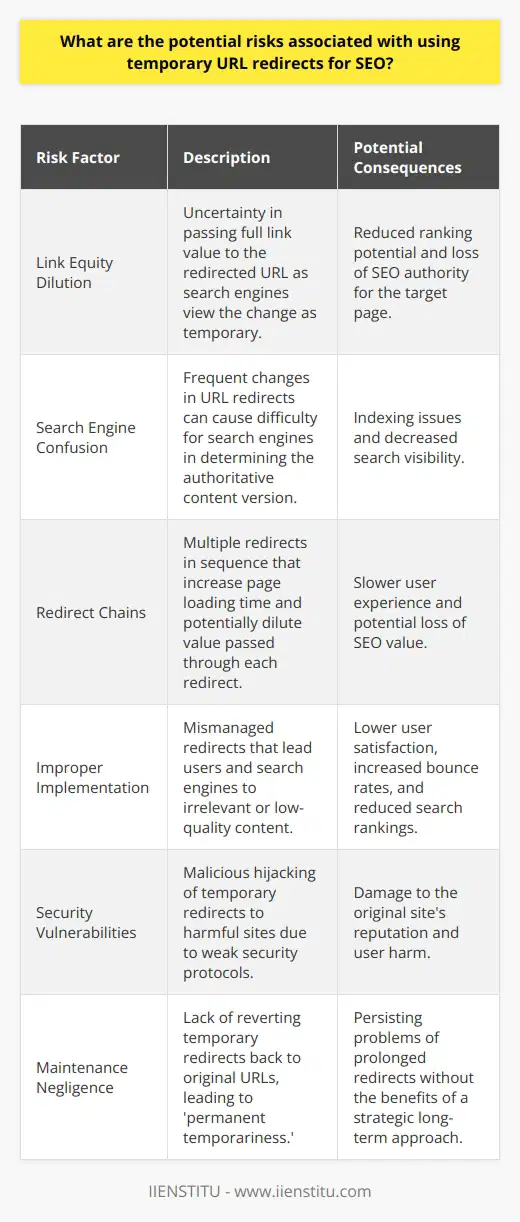
Which type of URL redirect is the most favorable for SEO?
Most Favorable Redirect for SEO
Understanding Redirects
A URL redirect is a technique employed by webmasters to guide users from one webpage or URL to another seamlessly. There are primarily three types of redirects – 301, 302, and 303. These numbers represent the HTTP status code received by a user's browser when accessing a web page. The choice of redirect has a considerable impact on search engine optimization (SEO), as each type carries different implications concerning the site's traffic, user experience, and search engine ranking.
301 Redirect: Permanent Movement
The 301 redirect is the most widely used and recommended type for SEO purposes. When a webmaster sets up a 301 redirect, they are telling search engines that the particular web page has permanently moved to a new location, and the search engine should index the new URL. As a result, this permanent redirect helps transfer the original page's authority, backlinks, and ranking to the new page.
302 Redirect: Temporary Shift
The 302 redirect is a temporary redirect, indicating that the original web page is currently unavailable, but the move will likely be reversed in the future. Such cases may arise during site maintenance or minor content updates. Since this redirect is temporary, search engines do not transfer the page authority, backlinks, or ranking to the new URL.
303 Redirect: User Experience Enhancement
The 303 redirect is mainly used to improve user experience by sending them to a different URL after completing a specific action, such as submitting a form or making a purchase. This type of redirect prevents users from re-submitting data and encountering duplicate transactions. However, it bears little significance to SEO as search engines do not index the new URL.
Conclusion: 301 Redirect is the Preferred Choice
From an SEO perspective, the 301 redirect is the most favorable option. It preserves the original page's authority, backlinks, and search engine ranking, thereby ensuring that the new web page benefits from the same level of exposure and traffic. Webmasters ought to carefully consider their website infrastructure and opt for 301 redirects to maximize SEO potential, especially during site migrations, redesigns, or consolidating similar content from multiple pages into a single one.
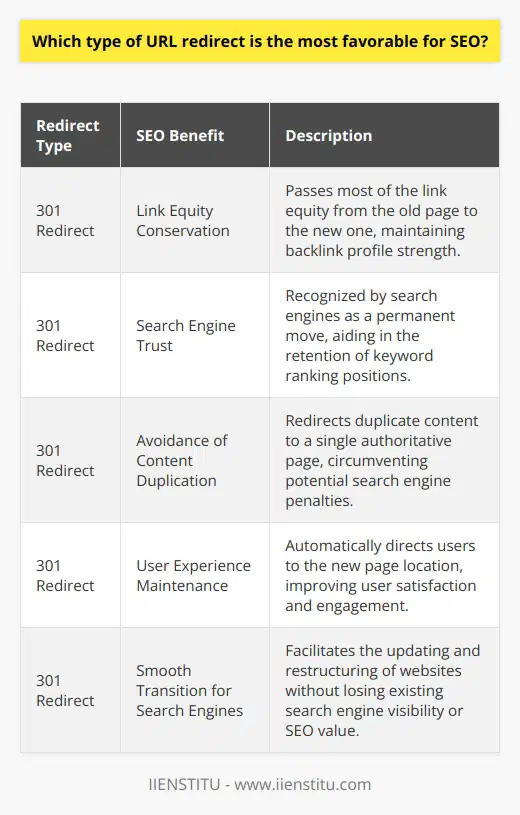
How many redirects are allowed for SEO?
Redirect Limits and SEO Implications
Understanding Redirects
In digital marketing, redirects are essential tools for both user experience and search engine optimization (SEO). Redirects automatically direct users and search engines from a specific Uniform Resource Locator (URL) to another, allowing for seamless navigation in cases when a webpage's URL changes.
Effect on SEO
It is crucial to consider SEO implications when implementing redirects. The number of redirects should be minimized to avoid losing valuable SEO assets such as domain authority, backlinks, and rankings. Multiple redirects may affect a website's loading speed, which is a significant ranking factor in search algorithms.
Recommended Number of Redirects
For proper SEO, the ideal number of redirects should be limited to one. This means that a user or search engine should only need to access the intended destination page by passing through one redirect. However, in cases where chains of redirects are unavoidable, it is recommended to keep the sequence as short as possible.
Potential Issues with Multiple Redirects
Using several redirects increases the chance of encountering problems such as redirect loops, broken links, and lost SEO value. Redirect loops occur when a URL redirects back to itself, resulting in users and search engines being unable to access the intended content. Broken links may ensue when a URL within a redirect chain no longer exists or is inaccessible. Lastly, if a redirect chain is too long, search engines may abandon the crawl, leading to the loss of potential ranking and organic traffic.
Optimizing Redirects for SEO
To ensure optimal SEO practices, it is essential to audit and monitor redirects regularly. Tools such as Screaming Frog, Google Search Console, and various Chrome extensions can help identify and resolve redirect chain issues. Ongoing maintenance helps resolve broken links, avoid redirect loops, and ensure a positive user experience.
In summary, a single redirect is preferred to minimize the negative impact on SEO. Although redirect chains should be avoided, if necessary, they should be kept as short as possible. Regular audits and maintenance are essential for optimizing user experience and maintaining a website's search engine rankings.
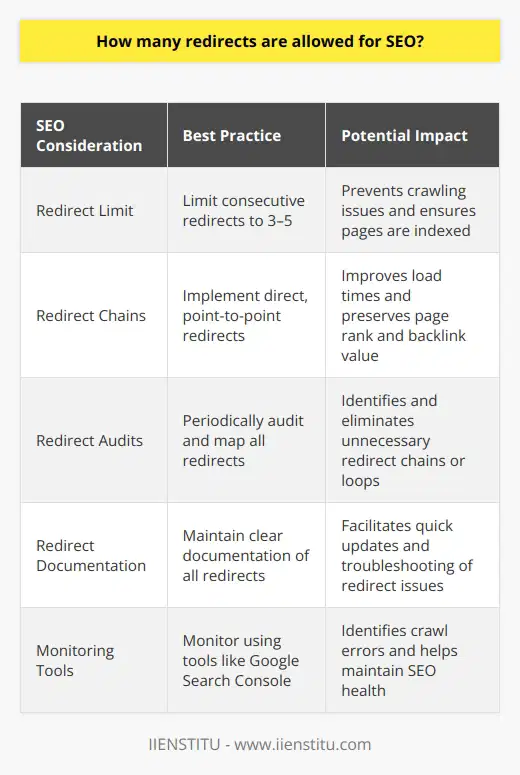
Does a 301 redirect hurt SEO?
Effect of 301 Redirect on SEO
Significance of 301 Redirect
A 301 redirect is an essential server response code that conveys a permanent redirection from a previous URL to a new one. It facilitates website migration, redesign, and restructuring, ensuring that users and search engines can seamlessly access updated content. Understanding the influence of a 301 redirect on Search Engine Optimization (SEO) is crucial for website managers and digital marketers, who aim to maximize organic traffic and enhance online visibility.
Impact on Search Rankings
A commonly held belief is that 301 redirects can negatively impact search rankings by spreading link equity and weakening the authority of the original URL. However, Google has affirmed that 301 redirects do not inherently hurt SEO as they pass nearly 100% of link equity from the source URL to the destination URL, ensuring search rank preservation. This indicates that, while the potential for a minimal reduction in link equity exists, its impact on search rankings is negligible, especially when implemented properly.
Necessity of Proper Implementation
Implementing 301 redirects effectively requires adherence to SEO best practices, which entail checks and precautions to prevent potential risks. Notably, one must ensure that the source and destination URLs have identical or closely related content, and that the targeted keywords, title tags, and meta descriptions are retained. This ensures that Google and other search engines can still recognize the relevance and context of the redirected content, even when the URL has changed.
Updating Internal Links and Sitemaps
In addition to proper implementation of 301 redirects, updating internal links and XML sitemaps is essential. Replacing old links with new ones helps avoid unnecessary redirects, simultaneously improving user experience and reducing the load on website servers. Furthermore, an updated sitemap can expedite the re-indexing process, allowing search engines to quickly recognize changes and maintain accurate search rankings.
Conclusion
In conclusion, 301 redirects do not hurt SEO when employed effectively and in accordance with search engine guidelines. Ensuring proper implementation and updating internal links and sitemaps can prevent link equity loss and maintain search rankings. Ultimately, 301 redirects serve as a valuable tool for website management, balancing long-term SEO objectives with specific technical requirements for an optimized online presence.
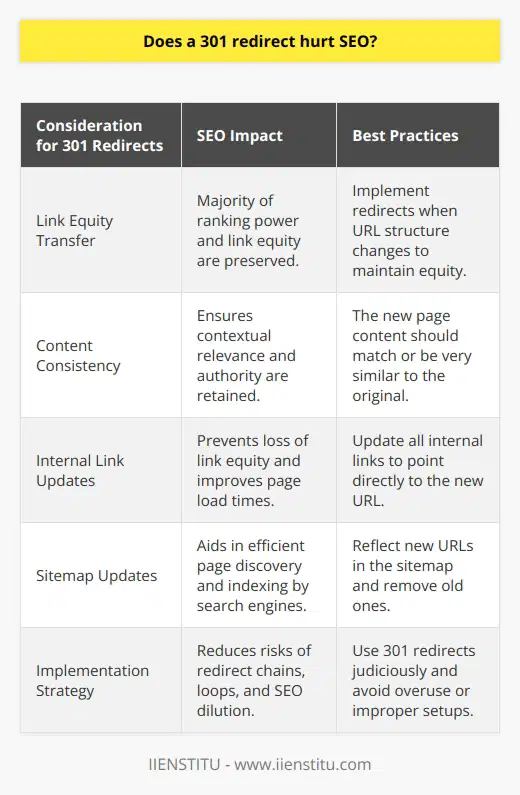
Does redirecting a URL affect SEO?
Impact on Search Engine Optimization
Redirecting a URL is an essential aspect of website management. It involves changing the original URL to a new one while ensuring that users and search engines can still access the content. Redirecting a URL can impact search engine optimization (SEO) in several ways, with factors such as the type of redirect used, the original and new URLs' relevance, and the search engine's ability to follow the redirect pathway.
Type of Redirects
There are two primary types of redirects: 301 (permanent) and 302 (temporary). A 301 redirect tells search engines that the content has moved permanently to a new location. It preserves the majority of the original URL's SEO value, transferring it to the new URL. In contrast, a 302 redirect signals that the content has temporarily moved, so search engines continue to index the original URL. Using a 301 redirect is more beneficial for SEO purposes, while a 302 redirect may not provide the same SEO benefits.
Relevance of the New URL
When redirecting a URL, it is crucial to ensure that the new URL is relevant in terms of content and topic to the original URL. Irrelevant redirects can reduce SEO value, as search engines may not associate the new URL with the original's context and keywords. Consequently, it may lead to a lower ranking in search engine results.
Search Engine Compliance
Redirects should be implemented correctly, adhering to search engine guidelines. Google, for instance, provides guidelines on proper implementation of redirects and how they may affect SEO. Misconfigured redirects may lead to search engines having difficulty following the new URL path, which can adversely impact SEO. It may result in a search engine treating the redirect as an error or disregarding it altogether.
In conclusion, redirecting a URL can affect SEO, but it depends on the type of redirect used, the relevance between the original and new URLs, and the correct implementation of the redirect. A well-executed 301 redirect can help maintain SEO value while ensuring a seamless user experience. Understanding the implications of various redirect types and adhering to search engine guidelines can minimize potential negative impacts on SEO.
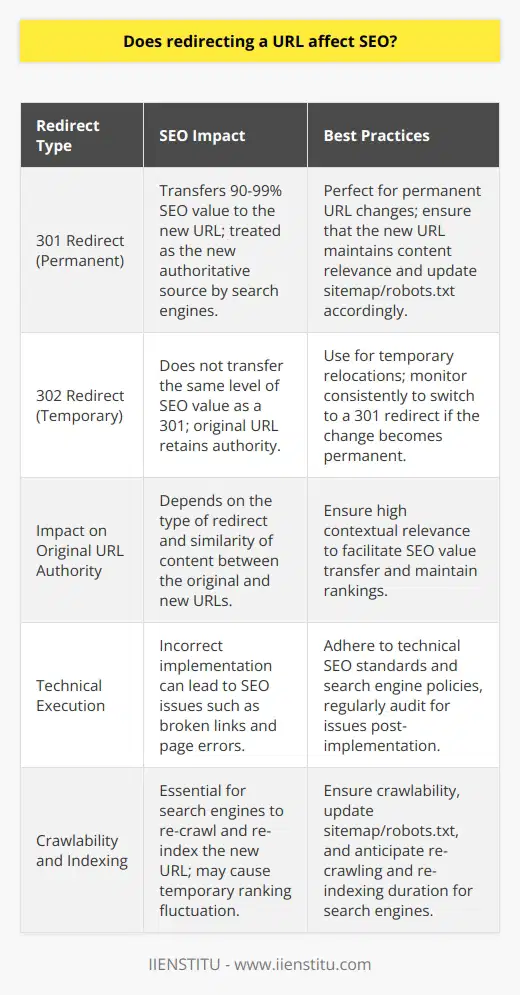
Is permanent redirect bad for SEO?
Impact on SEO
Permanent redirects, specifically 301 redirects, play a significant role in maintaining a website's search engine optimization (SEO) value. When implemented correctly, they help in transferring the link juice, authority, and organic search rankings from the old URL to the new destination.
Proper Implementation
However, the impact of a permanent redirect on SEO largely depends on its implementation. It is essential to identify the appropriate scenarios, such as domain migration or deleted content, where the use of 301 redirects actually benefits the SEO efforts.
Site Structure and User Experience
Moreover, the proper execution of permanent redirects can contribute to improved user experience by ensuring that users and search engines are directed to the most relevant and updated content available on the website.
Potential Drawbacks and Solutions
While permanent redirects are generally beneficial for SEO, they can lead to potential drawbacks if misused or overused. Multiple redirects, for instance, may cause delay in page loading time, which negatively affects user experience and search engine rankings. To prevent this, monitor the website to identify and fix redirect chains and loops.
Redirects Management
Consistent management of redirects is also crucial for preserving the website's SEO value. This includes regularly monitoring server logs and Google Search Console for error messages, crawl errors, and broken links, and promptly addressing any issues.
In Conclusion
Permanent redirects, when employed correctly, can significantly benefit a website's SEO value by maintaining link equity, authority, and organic search rankings. Implementing them judiciously, and regularly monitoring and addressing potential issues, ensures that a website continues to perform well on search engines and delivers a consistent user experience.
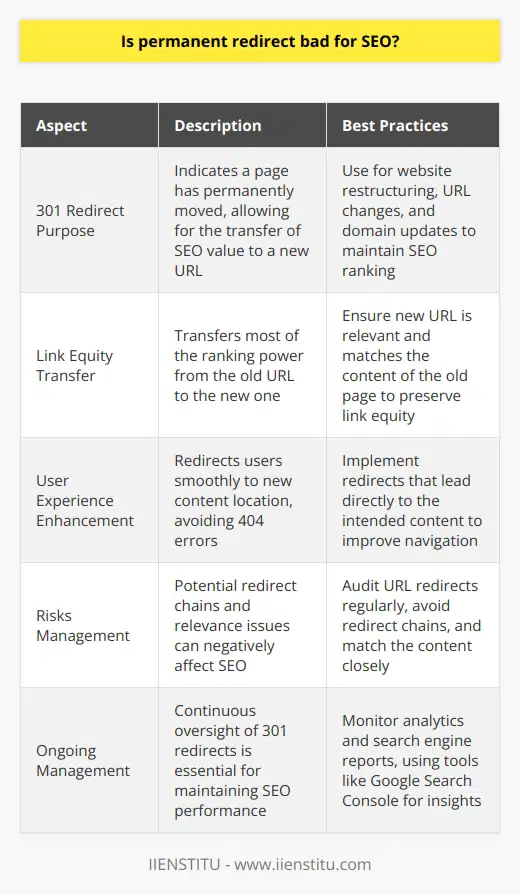
What redirect is best for SEO?
Benefits of 301 Redirects
In order to determine the best redirect for Search Engine Optimization (SEO), it is important to understand the advantages of different types of redirects. A 301 redirect is a permanent redirect that passes between 90-99% of link equity, also known as ranking power, to the redirected page according to Moz. This type of redirect is recommended for SEO when moving a webpage to a new URL, as it signals to search engines that the move is permanent and preserves the majority of the page's ranking power.
Impact on User Experience
A 301 redirect also benefits the user experience by avoiding the annoyance of broken links and maintaining consistent navigation throughout a website. When a user clicks on a link that has been permanently redirected, they are seamlessly taken to the new URL without encountering a 404 error. By maintaining a strong user experience, a website has the potential to attract and retain more visitors, which in turn can positively influence SEO rankings.
Comparison with 302 Redirects
In contrast to a 301 redirect, a 302 redirect is temporary and does not pass the same amount of link equity to the redirected page. This type of redirect is used when the move is intended to be temporary, such as during site maintenance or testing. However, Google and other search engines may perceive a 302 redirect as merely a temporary change and not transfer the full ranking power to the new URL, rendering it less beneficial for SEO purposes.
Conclusion
In conclusion, a 301 redirect is the best option for SEO when moving a webpage to a new URL permanently. It not only preserves the majority of the page's ranking power, but also contributes to a positive user experience by enabling seamless navigation. While a 302 redirect may be appropriate for temporary changes, it is not the optimal choice for pursuing strong SEO and maintaining a website's ranking potential.
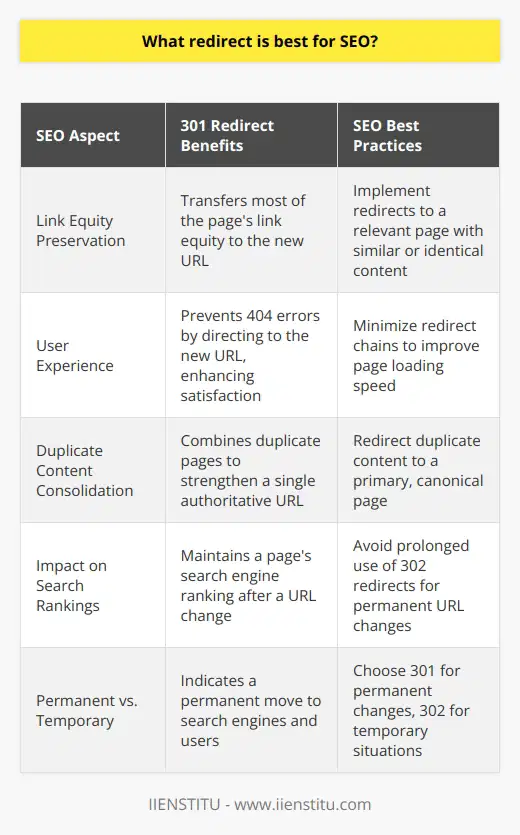
Does URL Redirect affect SEO?
Impact on SEO Rankings
URL redirection does affect SEO, but its impact can be either positive or negative. The impact primarily depends on the method of redirection used.
301 vs 302 Redirects
For instance, a 301 redirect transfers about 90-99% of link juice (ranking power), hence having a positive effect. Conversely, a 302 redirect does not pass on link juice, making it harmful to your SEO efforts.
Implementation of Redirects
Proper implementation of redirects plays a critical role. A wrongly configured redirect can result in a 404 error page, which negatively affects SEO by decreasing your site’s usability.
Redirect Chains
Additionally, redirect chains or loops can significantly slow down your website. A slow website can hurt your SEO as site speed is a crucial ranking factor.
Canonical Tags
Using canonical tags with redirects ensures your desired URL receives the ranking. It prevents duplicate content issues, which can harm SEO.
Maintaining Backlink Profile
Finally, redirects can help maintain a strong backlink profile during site migrations or redesigns. They transfer the link juice from old pages to new ones, thereby sustaining the SEO value.
In conclusion, URL redirection impacts SEO significantly. Correctly executed redirects with thoughtful planning can boost SEO efforts. Conversely, incorrectly executed redirects can lead to issues that hamper SEO rankings.
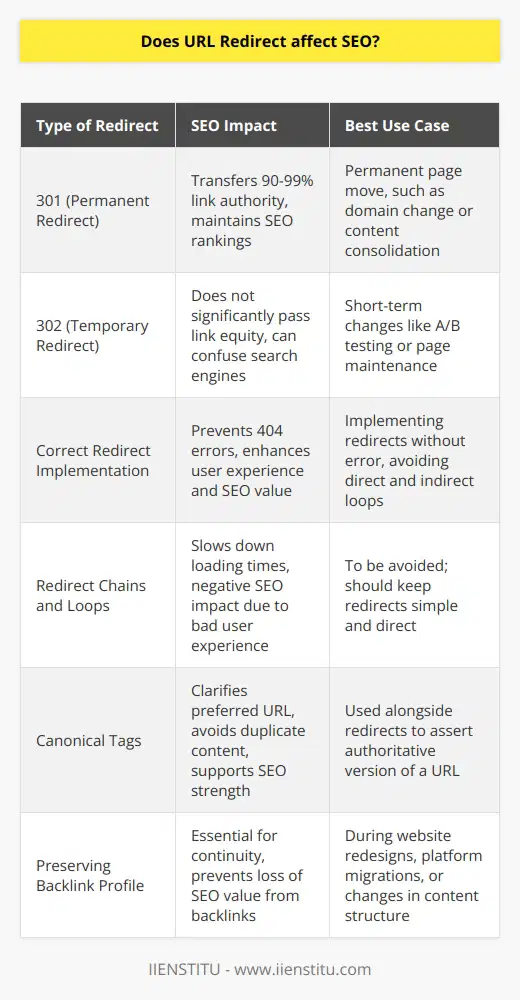
What redirect is best for SEO?
Optimal Redirects for SEO
301 Redirect and SEO
When considering search engine optimization (SEO), the best redirect is the 301. A 301 redirect is a permanent redirect from one URL to another. It signals to search engines that a page has moved definitively to a new location. Consequently, the majority of the link equity, or SEO value from the original page, transfers to the new location.
Impact on Page Ranking
This transfer of SEO value is critical to page rankings. It enables the new page to maintain the original page's rank. Besides, if the original page had acquired backlinks over time, a 301 redirect allows these backlinks to contribute to the new URL's ranking.
Avoiding 302 Redirects
While 302 redirects also move users and search engines to a new URL, they indicate a temporary move. As a result, a 302 redirect does not transfer the SEO value from the original page to the new one. This lack of transfer can limit the new page's rank on search engines.
Maintaining User Experience
Apart from SEO, 301 redirects also maintain a good user experience. They ensure that visitors, who have bookmarked or follow old links, get directed to the appropriate, updated content. This smooth user journey can indirectly benefit a site's SEO by reducing bounce rates.
In conclusion, a 301 redirect is the superior choice for SEO purposes. It provides the most efficient way to reassign SEO value from an old URL to a new one. Conversely, lower value redirects like the 302 can negatively affect a page's SEO. Therefore, site managers should use 301 redirects judiciously to preserve search rankings during site restructures or content updates.

How many redirects are allowed SEO?
Understanding Redirects in SEO
Navigation through the labyrinth of the internet is achieved through the judicious use of redirects. Essentially, they transport users from Page A to Page B, expediting the browsing journey.
Limitation on Redirects
There's a query among SEO professionals regarding limits on redirects. An underlying rule is that a maximum of five redirects is acceptable per URL request. This limit is set to optimize the speed and user experience.
Downside of Excessive Redirects
Excessive redirects could trigger an error called a redirect loop. Redirect loops impose a considerable strain on the load time, thus damaging the overall user experience. They could also compromise the crawl budget, hampering search engine optimization efforts.
Benefits of Proper Redirect Implementation
Properly implemented redirects ensure users and search engines land on the correct version of a webpage. This aids in maintaining good SEO practices, thwarting potential confusions, and enhancing overall website functionality.
Varied Search Engine Responses
However, Google and other search engines may respond to redirects differently. For example, Google follows up to five redirects per site, while Bing has a more flexible approach, following any number of redirects as long as there isn’t an excessive loop.
In conclusion, while the set limit is usually five redirects per URL request, the specific implications depend on the search engine's policies. Therefore, it's essential for SEO professionals to stay updated with the best SEO practices to maximize the benefits of redirects and avoid potential pitfalls.

Does redirecting domains help SEO?
Influence of Domain Redirection on SEO
Examining the relation between domain redirection and Search Engine Optimization (SEO) reveals a nuanced picture. To begin, domain redirection does not inherently improve or harm your SEO. However, the way you enact it can have an impact.
Impact of Permanent Redirection:
When permanently redirecting (301 redirection), search engines transfer the link equity of the old domain to the new one. This can conserve your SEO efforts. However, if redirection signals a significant change in content, it may affect SEO.
Effect of Temporary Redirection:
Temporary redirection (302 redirection) does not pass on the link equity. Use this when planning to revert to the old domain, but be aware it doesn't have SEO benefits.
Implication of Multiple Redirections:
Avoid multiple redirections (redirect chains). They can confuse search engines, delaying indexation of the new domain. Consequently, this can negatively impact SEO.
Role of Content Relevancy:
Redirecting to a domain with similar content and keyword relevance can maintain or even boost your SEO ranking. On the other hand, if the new domain's content differs greatly from the original, search engines may lower your ranking.
Usage of Canonical Tags:
Utilizing canonical tags appropriately can also prevent potential SEO issues during domain redirection. They inform search engines that certain pages have similar content, thereby preventing duplicate content issues.
Summary:
In conclusion, domain redirection does not outright assist SEO. Yet, if properly implemented, it can help maintain and even improve your SEO efforts.
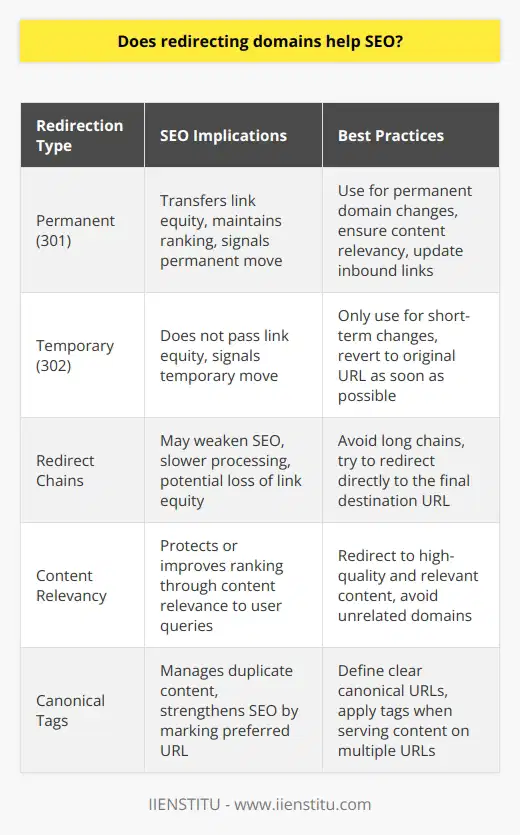
Should I use redirect or rewrite for SEO?
Understanding Redirect and Rewrite
To answer whether one should utilize redirect or rewrite for SEO, we first need to understand both these techniques. Redirect is a method in which an old webpage links to a new one. In contrast, rewrite is an approach where the URL of a webpage changes while the content remains same.
Advantages of Redirect for SEO
In terms of search engine optimization, using redirect can be beneficial when you are restructuring your website or removing outdated content. In such instances, a 301 redirect effectively communicates to search engines the relocation of the page. This preserves the link equity and maintains site ranking.
Limitations of Redirect for SEO
However, overuse of redirect can slow down the website loading speed which is detrimental to SEO. Too many redirects can also confuse search engines and result in crawl errors.
Opportunities with Rewrite for SEO
Rewrite serves the purpose of creating more legible and keyword-optimized URLs, enhancing the SEO by making the pages more search-engine friendly.
Caution with Rewrite
However, one should exercise caution as rewriting URLs might lead to duplicate content issues that can negatively impact your SEO.
To Sum Up
To conclude, both redirect and rewrite can provide SEO benefits when used correctly. The choice largely depends on your SEO strategy and website requirements. Adopting the use of redirects or rewrites without a well-established strategy, however, can lead to SEO drawbacks, such as reduced speed, crawl errors, and potential duplicate content. Your decision should always dovetail with your comprehensive SEO plan.
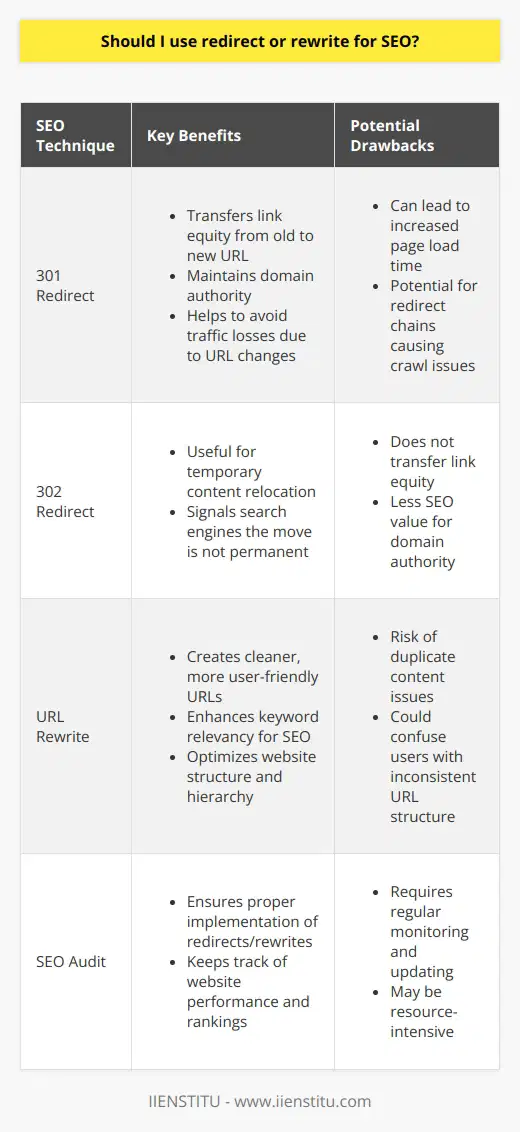
In the context of SEO, what are the potential benefits and drawbacks of using multiple redirects?
Benefits of Multiple Redirects in SEO
In the framework of Search Engine Optimization (SEO), multiple redirects can offer several benefits. Primarily, they can preserve the ranking power of an existing webpage when URL changes occur. For instance, you may migrate your site to a new domain or restructure your website. In this situation, redirects ensure search engines and users can find your new pages easily. Additionally, multiple redirects can help to reduce the chances of broken links and 404 error pages, improving user experience and SEO ranking.
Drawbacks of Multiple Redirects in SEO
However, using multiple redirects also comes with certain drawbacks. They can slow down your website load time, negatively impacting your SEO performance. It happens because the server takes more time to process a request via redirects. Also, if mishandled, multiple redirects can lead to redirect loops. This occurrence confuses search engines and users, resulting in poor website performance.
Furthermore, excessive use of redirects may dilute link equity. Despite 301 redirects passing most link equity, some might get lost in the process. Lastly, maintaining a large number of redirects can eventually become unwieldy and difficult to manage.
Conclusion
Thus, while multiple redirects can preserve a page's ranking power and improve user experience, potential pitfalls like slow site speed, confusing redirect loops, loss of link equity, and management complexity exist. Therefore, use multiple redirects cautiously, ensuring they add value to your SEO efforts while minimizing the risks.
